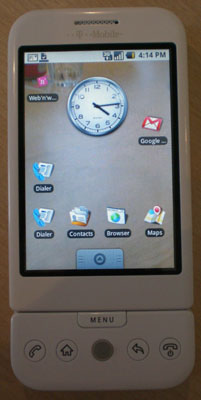 A mobile app is a program or website that works on a mobile phone, particularly smartphones like the iPhone or the T-Mobile G1.
A mobile app is a program or website that works on a mobile phone, particularly smartphones like the iPhone or the T-Mobile G1.
What to keep in mind:
- The screens are small and come in different sizes.
- On the Internet they are slow: it is 1995 all over again.
- They can be used outdoors where the lighting is different.
- A telephone call can come in during the middle of your app.
- Typing and clicking are much more painful to do.
- They are commonly used repeatedly in odd moments throughout the day.
- Most have cameras and some even accelerometers and GPS.
- Battery life has to be considered.
- It is hard to use more than one app at a time.
- If your app does not do something useful in 30 seconds, then it is useless.
Some notes on designing a mobile app:
- Think about what people want to know, do and feel. Make users feel good about what they are doing. Your aim is not to show off but to make life easier, better and simpler for them.
- Avoid shovelware: design it for the mobile phone from the ground up.
- About half your time will be spent in design, the other half in coding and testing.
- Design on paper with a fat marker. Do not try to put too much on a screen: keep it simple. Design all screens and the complete flow between them. When you think you are done, go back over it and make it better. Do that again and again. Design as much of the app on paper as possible.
- Build on the user’s experience of the physical world.
- Without scrolling the user should see branding, the most frequently used functions and the most important information.
- Cut out all typing, clicking, scrolling and zooming wherever possible.
- Prefer scrolling to clicking.
- People see and understand images and colours first. They look at things with rounded corners.
- Use presets that covers 80% of users.
- Get something simple working first. Then add to it bit by bit, but keep it solid. Then make it fast. Then make it good-looking. Then make it cool.
- Eat your own dog food: use the app for yourself.
- Scratch the itch: if something about the app gets to you, then make it right and good.
- Test, test, test:
- Test for speed.
- Test on all supported mobile phones.
- Test indoors and outdoors.
- Test when a call comes in.
- Get it as good as you can before you put it out: if users do not like it, they will not wait for the update.
- Remember you can use sound – but do not depend on it.
- For websites:
- Use simple HTML for the things on your pages.
- Use CSS to make it look cool.
- You can use JavaScript, but do not count on it always being supported.
- Do not use a fixed-width layout. Do not count on more than 240 x 320.
- Provide links to both the mobile and full version of the website (if they are different).
See also:




